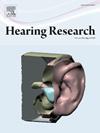Chirp sensitivity and vowel coding in the inferior colliculus
IF 2.5
2区 医学
Q1 AUDIOLOGY & SPEECH-LANGUAGE PATHOLOGY
引用次数: 0
Abstract
The inferior colliculus (IC) is an important brain region to understand neural encoding of complex sounds due to its diverse sound-feature sensitivities, including features that are affected by peripheral nonlinearities. Recent physiological studies in rabbit IC demonstrate that IC neurons are sensitive to chirp direction and velocity. Fast spectrotemporal changes, known as chirps, are contained within pitch-periods of natural vowels. Here, we use a combination of physiological and modeling strategies to assess the impact of chirp-sensitivity on vowel coding. Neural responses to vowel stimuli were recorded and vowel-token identification was evaluated based on average-rate and spike-timing metrics. Response timing was found to result in higher identification accuracy than rate. Additionally, rate bias towards low-velocity chirps, independent of chirp direction, was shown to correlate with higher vowel-identification accuracy based on timing. Also, direction bias in response to chirps of high velocity was shown to correlate with vowel-identification accuracy based on both rate and timing. Responses to natural-vowel tokens of individual neurons were simulated using an IC model with controllable chirp sensitivity. Responses of upward-biased, downward-biased, and non-selective model neurons were generated. Manipulating chirp sensitivity influenced response profiles across natural vowel tokens and vowel discrimination based on model-neuron responses. More work is needed to match all features of model responses to those of physiological recordings.
下丘的啁啾灵敏度和元音编码
下丘(IC)是理解复杂声音神经编码的重要脑区,因为它具有不同的声音特征敏感性,包括受外周非线性影响的特征。最近对兔内窥镜的生理学研究表明,内窥镜神经元对啁啾的方向和速度非常敏感。快速的光谱时间变化,被称为啁啾,包含在自然元音的音高周期内。在这里,我们使用生理和建模策略的组合来评估啁啾敏感性对元音编码的影响。记录对元音刺激的神经反应,并根据平均速率和峰值时间指标评估元音标记识别。结果表明,响应时间的准确性高于识别率。此外,与啁啾方向无关的低速啁啾的速率偏差与基于时序的更高元音识别精度相关。此外,高速啁啾的方向偏差与基于速率和时间的元音识别精度相关。使用具有可控啁啾灵敏度的IC模型模拟单个神经元对自然元音标记的响应。产生了向上偏置、向下偏置和非选择性模型神经元的响应。操纵啁啾灵敏度会影响自然元音标记和基于模型神经元反应的元音辨别的反应概况。将模型反应的所有特征与生理记录的特征相匹配还需要做更多的工作。
本文章由计算机程序翻译,如有差异,请以英文原文为准。
求助全文
约1分钟内获得全文
求助全文
来源期刊

Hearing Research
医学-耳鼻喉科学
CiteScore
5.30
自引率
14.30%
发文量
163
审稿时长
75 days
期刊介绍:
The aim of the journal is to provide a forum for papers concerned with basic peripheral and central auditory mechanisms. Emphasis is on experimental and clinical studies, but theoretical and methodological papers will also be considered. The journal publishes original research papers, review and mini- review articles, rapid communications, method/protocol and perspective articles.
Papers submitted should deal with auditory anatomy, physiology, psychophysics, imaging, modeling and behavioural studies in animals and humans, as well as hearing aids and cochlear implants. Papers dealing with the vestibular system are also considered for publication. Papers on comparative aspects of hearing and on effects of drugs and environmental contaminants on hearing function will also be considered. Clinical papers will be accepted when they contribute to the understanding of normal and pathological hearing functions.
 求助内容:
求助内容: 应助结果提醒方式:
应助结果提醒方式:


